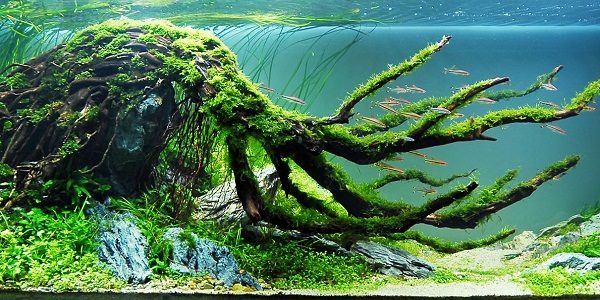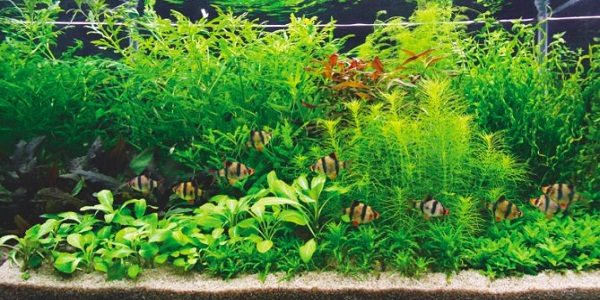The biotope aquarium is an exact replica of a specific natural aquatic landscape. From the rivers of the Amazon Rainforest to the tropical reefs of Australia, a biotope aquascape replicates every aspect of the natural version from the fish and flora to the water temperature and chemistry. Depending on the setting of your choice, there are numerous key traits to consider; however, the primary goal is to always create a scene that would be reflective of what could be naturally taking place in a river, swamp, or other aquatic terrain. As a result, the primary challenge of every biotope aquascape is compatibility and maintenance; typically these environments are highly sensitive and unique to an area, which in turn makes management and simulation of these environments equally difficult. Numerous moving pieces must be managed, such as the water chemistry, compatible fish, and plant life that are all able to live harmoniously. The biotope style, although difficult and strict in implementation, can also lead to one of the more dynamic and unique aquariums.

Table of Contents
Primary Features
The biotope aquascape is a unique representation of an actual aquatic setting that should also incorporate its natural inhabitants. As the designer, your primary goal is to discover a mix of the correct plant life and fish species, coupled with a realistic layout and environment that could be found in a natural setting. This could present challenges in regards to maintenance, however the guidelines for your biotope are clear cut and nonnegotiable. A true biotope’s focus is to create a natural environment that also incorporates its endemic inhabitants. As a result, there are many common biotope aquascapes that have been recreated, such as:
- New Guinea River
- North American Swamps
- South American Blackwater Creeks
- Mountain Streams
- Subterranean Caves
Creating a biotope in line with these ecosystems each present their own unique features as they are all natural environments that can be found today. In turn, the implementation of these biotopes also requires a significant amount of knowledge and understanding in the plant and fish species of these areas.
Recommended Designs and Layout
When creating your biotope design, the core principle should be to recreate a setting that can be found in nature. As a result, the layout of a biotope aquascape does not typically follow a prescribed set of guidelines. However, fundamental aquascaping principles can still be implemented using a single focus point and implementing hardscape common in biotope styles. For example, using a centerpiece of wood can give the illusion of a root in the Amazon Rainforest. In comparison, using stones and fine substrate can also be used to recreate an Australian or New Zealand stream.

Recommended Features
In a similar fashion, there are no strict guidelines or recommended plant and fish species in a biotope style aquarium. The focus remains to be the recreation of a natural environment and in turn the species used in your aquascape should be reflective of that vision. Even beyond the fish or plant species in your design, the substrate and hardscape used should also be in line with the natural environment chosen. To help get started, here are couple of examples of species found in the most popular biotope designs.
- South American Blackwater Creek
- Fine gravel, sand, or clay at substrate level.
- Plant species such as Sword Plants or Vallisneria.
- Fish species such as Angelfish, Tetras, and Dwarf Cichlids.
- New Guinea River
- Fine gravel or clay substrate to nurture the dense plant life.
- Plants such as Vallisneria, Ceratopeteris Bolbitis, and other rich green flowing plant species.
- Fish species such as Bettas, Rasboras, or Glass Catfish.
Related Post: Understanding Iwagumi Aquascaping Style
Challenges with Biotope Aquascapes
The aspect of the biotope design that makes it enjoyable is it’s challenging. Creating a biotope aquarium requires significant knowledge and maintenance to sustain a healthy environment. A deep understanding of the ecosystem is required to make a biotope that can live harmoniously and sustain life. On top of these facts, the equipment required can also be unique and expensive. However, this does depend on the environment the biotope is meant to recreate, considering a swamp or stagnant biotope will not require as much supplemental filtration as other tanks.
Beyond the challenges found in maintenance and deep understanding of the recreated ecosystem, the biotope style also provides significant benefit in the preservation of these ecosystems. A true biotope will be able to recreate the ecosystem and could also provide a refuge to sustain endangered species, as a result this style of aquascaping serves more than just aesthetic purposes. The clear challenges of this style of aquascaping require significant knowledge and skill, but the reward in making such a biotope will be an accurate representation of the aquascaper’s skill and commitment.
